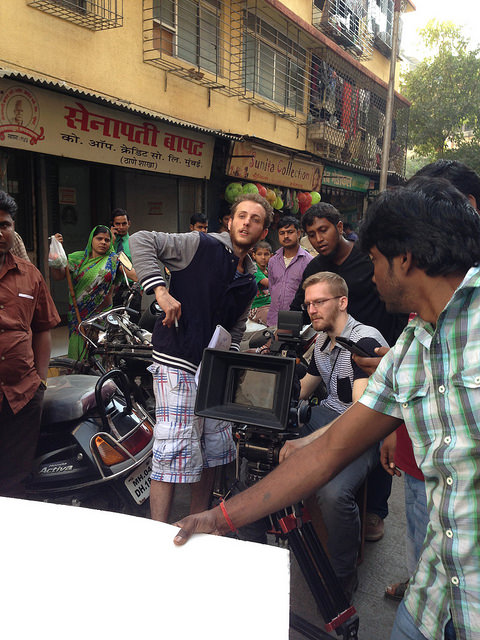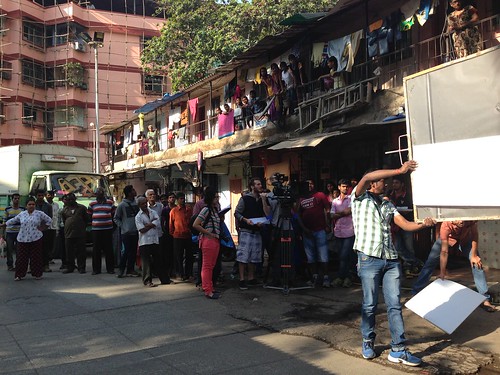
How was India: Part One

We had a crowd for the set.
Last Tuesday night I arrived back to the great state of Illinois after traveling for over thirty hours from across the globe. I was jet lagged and exhausted—I still am. I’ve been walking around in a daze lately, shocked and stressed, still processing.
Then the question comes: How was India?
Oh this question.
I’ve been asked this so many times already yet every time someone wants to know, I can hardly figure out where to start my story. I went abroad and experienced a completely different culture. I made a film in this country with a small but mighty team and extremely limited resources. I was culture shocked, hustling in the setting of a tight production schedule (aka, the pressure cooker), pushing myself and team to the brinks, and making one of the best films that I have ever had the pleasure to be a part of.
It was crazy. Seriously. It was chaotic and indescribable in many ways. Like I said, I’m still dazed and it’s been almost a month since we wrapped the production. How do you describe the most educational and perspective-changing experience of your life to your peers? It’s not enough to say it in just these words. Where do you begin? How much do you share? How do you show how much you’ve changed as a result of this experience?
Currently, my biggest challenge is going to class and wanting to share every last drop of my experience with all of my classmates—just in hopes that I can rub some of this off onto other people around me. I’m pretty sure I could write a book about my experiences this year. Maybe I will. In the meantime, I want to share some of the biggest takeaways that I had from filmmaking abroad.
Takeaway One: Taste the Land
This is something that I found particularly helpful during both my time filming in Italy and India. I cannot stress enough the importance of truly taking the time to let yourself as the filmmaker assimilate to the setting around you. Before any work is started (if you are new to the setting), it is necessary to let yourself see the place you are in and to experience it in order to responsibly tell a story based in it.
I’m not talking about walking around and taking some pictures, going site-seeing and such. I’m talking about spending time with the people, the places, the smells and the sounds. Mumbai in particular has a lot of these things to take in—it’s loud, crowded, smelly, and dense in every way imaginable.
The location will tell a story within your film all on it’s own. We found that getting to know this place shifted our perspectives, made us look at how we would share the characters and the events, and it helped us to see how our story could legitimately happen in this place.
This was crucial to our experience. We had a perspective of the location before we had ever seen it. We could have just gone, shot the film, and wiped our hands at the end of the day. But as soon as you walk around a place like India with your script in your hands, it becomes obvious how much this place will strangle you and your story if you don’t listen to what it has to say.

Our brilliant gaffer, Ashok, and me.
The authenticity of our film, as if not important enough to consider already, triplicated when we gave ourselves time to familiarize with the location. It became a story device of it’s own and it was critical to consider how this process evolved into the interesting concept of location-based storytelling.
Beyond that, it is simply important for you and your crew to experience as much culture shock before production as possible. This not only applies to the authenticity of the film but is appropriate for the mental and physical adjustment for your team.
Takeaway Two: The Saving Grace of Good Pre-Production and Pre-Visualization
Being in a new country already puts a weight on you as a person. Having the duty of making a film adds another element completely. It shouldn’t even need to be said but because of that, the importance of pre-production and pre-visualization becomes even more key than it was before (and just FYI—it was already really important).
We place a lot of stress on what to do on set and how to develop our stories but having effective pre-production is vital. During my time in Mumbai, I had one of the best pre-production experiences with my director as we constructed overheads, shot lists, shot analyses, visual design boards, and storyboards with our storyboard artist, Ernesto.
With such care taken to break down every detail of every shot in the film, I never felt more prepared to do my job on set. I was equipped with the film already complete in my head. I knew what each shot was to look like, how the image was to be constructed, and it’s visual relevance and symbolism to the story. I could tell you what shot something would be coming from and what it was leading into.
If you think for a moment that this is the sole job of the director to hold this information, you are wrong. Knowing this much detail about the plan for this film told me, as the First AD, everything that needed to happen on set for us to be successful. It told me how to communicate with every person on my team and it expedited every single creative AND logistical conversation that I had on set. It’s an eye opener to the fact that ever person on your team, no matter what the role, needs to know what our goal is—what are we working towards?
All of this was only possible because I spent so much time working closely with the director on what needed to happen to tell the story best. We took all of that pre-visualization work and we brought it with us on set for reference. We equipped ourselves with a bound book that held every visual, written description, and breakdown that we ever discussed and how it motivated everything. We took the film seriously and this book became our bible. As a result, the difference will be evident on screen. I honestly do not know how to say this any differently in order to tell you how deeply accurate this is.

Going for a take amidst the chaos.
My experience on this film is one that has taken my breath away and still continues to do so as everything finally sinks in. But because there is so much to say further on my experiences with this film, please check back for the next blog as I explain available tools to filmmakers of all kinds and the importance of understanding all the roles and functions on set.
